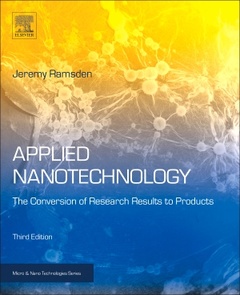Description
Applied Nanotechnology (3rd Ed.)
The Conversion of Research Results to Products
Micro and Nano Technologies Series
Author: Ramsden Jeremy
Language: English
Subjects for Applied Nanotechnology:
Keywords
<; p>; Nanotechnology; Nanoinformation; Nanobusiness; Green Nanotechnology; Nano-energy<; /p>
Support: Print on demand
Description
/li>Contents
/li>Readership
/li>Biography
/li>Comment
/li>
Applied Nanotechnology: The Conversion of Research Results to Products, Third Edition, takes an integrated approach to the scientific, commercial and social aspects of nanotechnology, exploring the relationship between nanotechnology and innovation, the changing economics and business models required to commercialize innovations in nanotechnology, and product design challenges that are investigated through case studies. Applications in various sectors, including composite materials, energy and agriculture are included, as is a section on the role of the government in promoting nanotechnology. In addition, the potential future of molecular self-assembly in industrial production is discussed, along with the ethics and social implications of nanotechnology.
This new edition begins a concise introduction to nanotechnology, carefully explaining the relationships between science, technology, wealth and innovation. Next, it focuses on actual products and processes, including the big three areas of application, health, IT and energy. Different types of nanobusiness (upstream, downstream, ancillary etc.), are also carefully delineated, and aspects such as design and realization (e.g., actual fabrication) are also covered, amongst other timely topics. This book offers a vision of the role of nanotechnology in confronting the challenges facing humanity, from healthcare to climate change.
PART I TECHNOLOGY BASICS1. What is nanotechnology?2. Science, technology and wealth3. Innovation4. Why nanotechnology?
PART II NANOTECHNOLOGY PRODUCTS AND SYSTEMS5. How nanotechnology fits into a modern industrial economy6. Nanotechnology for health7. Nanotechnology for energy8. Nano-info technology9. Other applications10. The design of nanotechnology products11. The realization of nanotechnology products
PART III ORGANIZING NANOTECHNOLOGY BUSINESS12. The business environment13. The fiscal environment14. The safety of nanotechnology15. Regulatory, legal and insurance matters16. Case studies of successful and unsuccessful nanotechnology companies17. Global nanotechnology
PART IV. WIDER AND LONGER-TERM ISSUES18. The future of nanotechnology19. Can nanotechnology meet society’s grand challenges?20. The impacts of nanotechnology
Engineers, Scientists and Entrpreneurs involved in the commercialization of nanotechnology across sectors including drug development, semiconductors / electronics, automotive / aerospace, energy
- Written by an author who has direct, hands-on experience working in a large nanotechnology-based company, in academia as a professor and chair of nanotechnology, and as the co-owner and director of a nanotechnology-based start-up
- Presents comprehensive coverage in an integrated fashion, not wasting space on trivial details that, if not already known to the reader, can be readily found in generic sources
- Thoroughly revised, reflecting advances in the field
- Includes areas that have been expanded into nanotechnology, such as health, and the safety of nano products and processes




